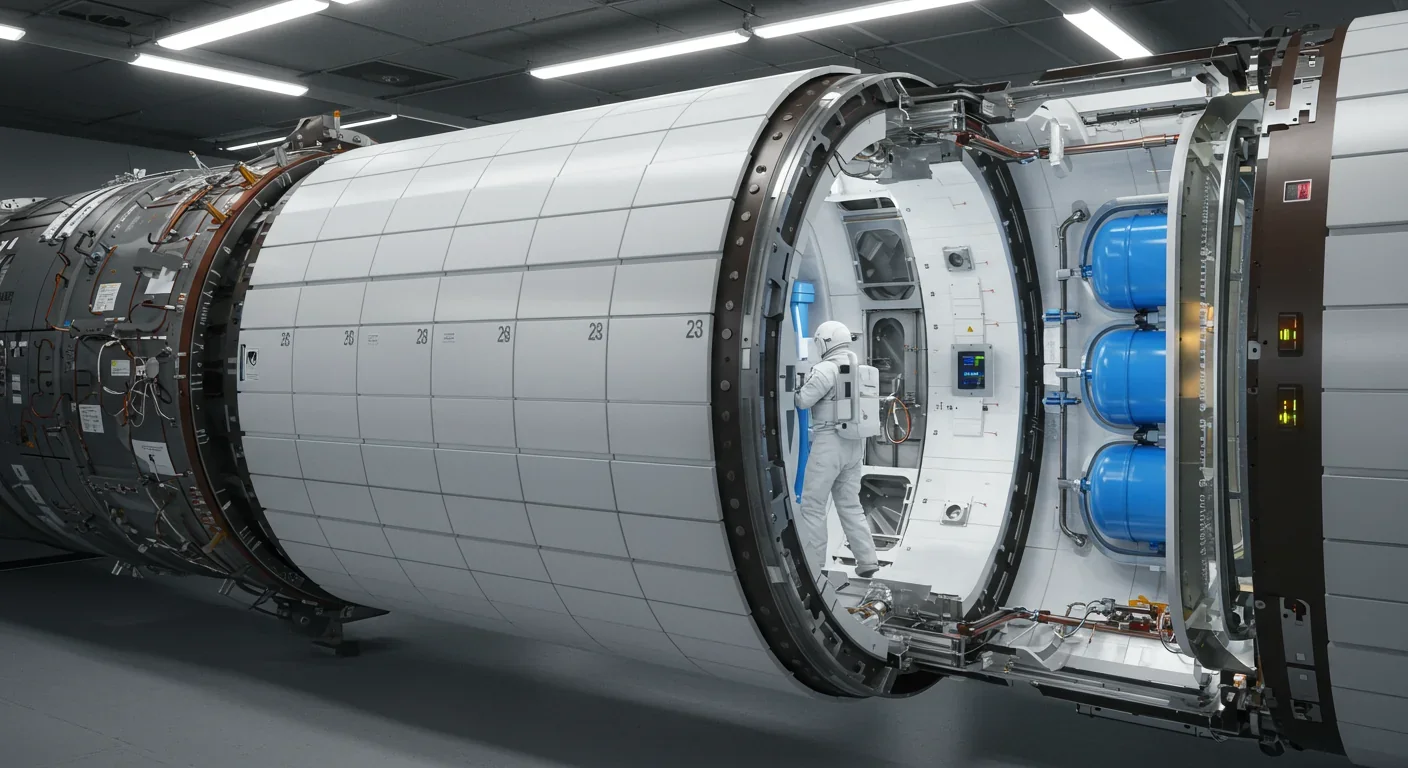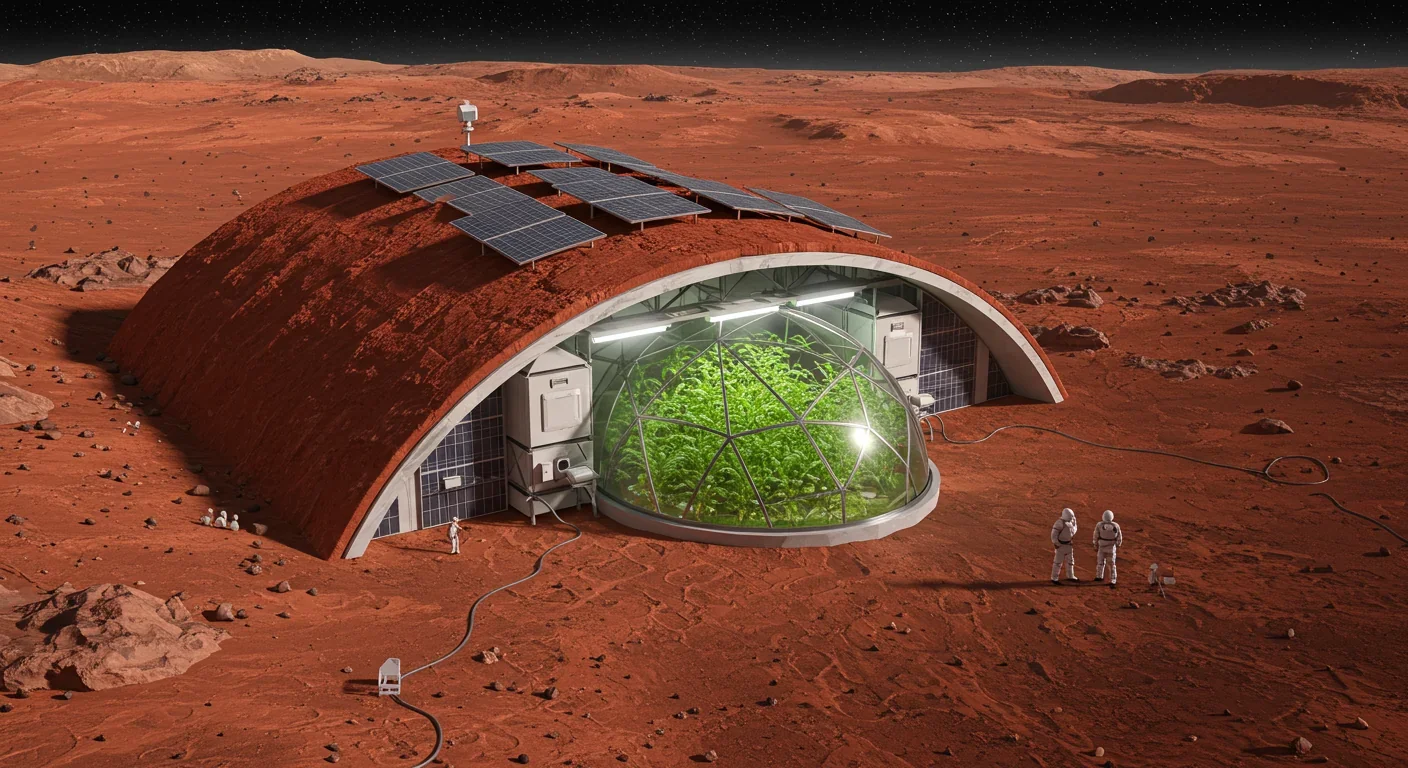Fusion Rockets Could Reach 10% Light Speed: The Breakthrough

TL;DR: Mars exposes astronauts to radiation levels 700 times higher than Earth. Scientists are developing solutions from hydrogen-rich polymers and water shielding to using Martian soil itself, plus experimental magnetic fields that could deflect cosmic rays like Earth's magnetosphere.

The first human to step onto Martian soil will face a danger more insidious than dust storms or equipment failures. It's invisible, relentless, and comes from the cosmos itself. Without Earth's protective magnetic field and thick atmosphere, Mars exposes astronauts to radiation levels 700 times higher than what we experience at home. A three-year mission could deliver a lifetime's worth of radiation in months, increasing cancer risk and potentially causing acute radiation sickness during solar storms.
This isn't a distant problem. NASA aims to land humans on Mars in the 2030s, and SpaceX has even more ambitious timelines. But here's the thing: we can't just slap some metal plates on a spacecraft and call it shielded. The solution demands innovation across materials science, spacecraft design, and in-situ resource utilization that transforms the Martian landscape itself into protection.
Cosmic radiation comes in two flavors, both dangerous. Galactic cosmic rays are high-energy particles from exploded stars beyond our solar system, traveling at near-light speeds and penetrating deeply into materials and living tissue. They're constant, unavoidable, and particularly effective at damaging DNA.
Then there are solar particle events: massive eruptions from the Sun that flood space with protons and heavier ions. These storms are unpredictable and can deliver lethal doses within hours if astronauts aren't properly sheltered. On Mars, where the surface receives about 233 millisieverts per year compared to Earth's 2.4 millisieverts, every expedition becomes a calculated risk against an invisible clock.
The challenge isn't just the quantity of radiation but its quality. When cosmic rays slam into shielding materials, they create secondary particles through a process called spallation. Traditional aluminum spacecraft hulls actually make this worse—the collision fragments can be more biologically harmful than the original cosmic ray. This means conventional approaches need rethinking from the ground up.
Earth enjoys natural protection we take for granted. Our magnetosphere deflects charged particles, and our atmosphere provides an equivalent of about 10 meters of water shielding. Mars has neither. Its ancient magnetic field died billions of years ago, and its atmosphere is less than 1% the density of Earth's. Any protection must be engineered, launched, or built from local materials.
The most promising passive shielding material isn't exotic—it's polyethylene, the same plastic in milk jugs and grocery bags. What makes it special is hydrogen. Hydrogen atoms are nearly the same mass as incoming protons, making them ideal for absorbing and scattering radiation through elastic collisions. When a cosmic ray hits hydrogen-rich materials, energy transfers efficiently without creating dangerous secondary particles.
NASA's research has shown that high-density polyethylene (HDPE) can reduce radiation exposure by 10-20% compared to aluminum of the same mass. But there's a catch: effective shielding requires thickness. For deep space missions, you'd need layers 20-30 centimeters thick to significantly reduce cosmic ray exposure, and that translates to launch costs measured in millions of dollars per centimeter.
Water offers an elegant solution to the mass problem because it serves double duty. A spacecraft's water supply—for drinking, hygiene, and oxygen generation—can be strategically positioned to provide radiation protection. Picture water bladders lining crew quarters or creating emergency storm shelters. When a solar particle event is detected, astronauts retreat to a water-surrounded haven, using the same resource they need for survival as temporary shielding.
The cutting edge, though, is in nanomaterials. Boron nitride nanotubes, for instance, combine low mass with exceptional strength and radiation-stopping power. These materials could be woven into spacecraft fabric, integrated into hull structures, or even incorporated into spacesuits. Research suggests they're particularly effective against neutron radiation while adding minimal weight—a critical advantage when every kilogram costs thousands to launch.
Here's where it gets clever: the most abundant shielding material is already on Mars. Regolith, the loose rocky soil covering the planet's surface, provides excellent radiation protection. Studies by NASA and ESA indicate that 2-3 meters of regolith offers protection equivalent to what astronauts experience on the International Space Station.
The vision is habitats buried under Martian soil or built into natural features like lava tubes and craters. Instead of hauling shielding from Earth, construction robots could pile regolith over inflatable modules, 3D-print structures directly from Martian soil, or excavate underground chambers. Craters offer a particular advantage—their walls provide natural shielding from certain angles, reducing the amount of additional material needed.
This approach faces engineering challenges, certainly. Regolith is abrasive and potentially toxic due to perchlorates in Martian soil. Habitats must seal perfectly while supporting tons of soil overhead. But the mass savings are enormous. Rather than launching shielding, you launch the equipment to build shielding, dramatically improving mission economics.
There's another in-situ resource worth mentioning: water ice. Mars has substantial ice deposits, particularly near the poles and in permanently shadowed craters. Ice could be mined and used as both a life support resource and radiation shield, creating closed-loop systems where the same water protects astronauts, grows food, and generates breathing oxygen.
Passive shielding—just putting stuff between you and radiation—has limits. Active shielding uses electromagnetic fields to deflect charged particles before they reach the spacecraft, mimicking Earth's magnetosphere on a small scale. This isn't science fiction; the physics is well understood. The engineering challenge is massive.
Creating a magnetic field strong enough to deflect cosmic rays requires superconducting magnets generating fields of several tesla, sustained continuously. The power demands are staggering—potentially megawatts for a field large enough to protect a crewed spacecraft. You'd need a dedicated nuclear reactor or enormous solar arrays, plus cryogenic cooling systems to maintain superconductivity.

Recent advances offer hope, though. Chinese researchers achieved record magnetic field strengths above 35 tesla using high-temperature superconductors, significantly reducing cooling requirements. If such systems can be scaled and made space-compatible, active shielding transitions from theoretical to plausible.
The concept becomes more feasible for stationary applications. A Mars base could dedicate substantial power to magnetic shielding, protecting a fixed habitat rather than a moving spacecraft. Solar arrays spread across kilometers of Martian surface could generate the necessary electricity, and the superconductors wouldn't face launch vibrations or microgravity challenges.
Electrostatic shielding represents another active approach, using high-voltage fields to repel charged particles. This requires less power than magnetic systems but introduces different challenges: managing electrical discharge in the thin Martian atmosphere and preventing dangerous charge buildup. Still, research continues as scientists explore whether combining electrostatic fields with passive materials might offer synergistic protection.
NASA's Artemis program is our real-world laboratory for deep space radiation protection. The Artemis II mission will carry six Hybrid Electronic Radiation Assessors monitoring radiation inside the Orion spacecraft. These sensors will provide real-time warnings during solar storms, allowing mission control to direct crew into sheltered areas with enhanced protection.
Artemis I, the uncrewed test flight, proved Orion's design provides adequate shielding for lunar missions. Radiation sensors throughout the capsule confirmed that strategic placement of equipment, supplies, and water storage created safe zones even during elevated radiation periods. This operational validation shows that intelligent spacecraft design, even without exotic materials, can manage radiation risk.
SpaceX's Starship presents a different philosophy. The massive vehicle's sheer internal volume allows for creative shielding placement. Propellant tanks could double as radiation barriers, and cargo sections might be configured as storm shelters. The stainless steel hull, while not optimal for radiation stopping, provides structural support for additional shielding layers applied to crew areas.
Private research initiatives are exploring unconventional solutions too. Some propose using spacecraft waste—food packaging, equipment containers, even biological waste—as improvised shielding mass. Over months in space, these materials accumulate and can be arranged around sleeping quarters or safe rooms, turning trash into protection.
Beyond hardware, there's a biological dimension to radiation protection that often gets overlooked. Understanding how the human body responds to space radiation helps optimize shielding strategies and medical countermeasures.
Research aboard the International Space Station reveals that stem cells behave differently in space, potentially affecting how the body repairs radiation damage. Astronauts experience accelerated aging at the cellular level, though the mechanisms aren't fully understood. This underscores why radiation protection isn't just about blocking particles—it's about preserving long-term health for people who will spend years away from Earth.
Pharmaceutical countermeasures could complement physical shielding. Radioprotective drugs, taken before anticipated high-radiation events, might reduce cellular damage. Antioxidant supplements could help repair oxidative stress from radiation exposure. These approaches won't replace shielding, but they might reduce the mass requirements, allowing lighter spacecraft that still keep crews safe.
Mission planning plays a crucial role too. Launching during solar minimum—the quiet phase of the Sun's 11-year cycle—reduces radiation exposure during transit. Timing Mars surface operations to avoid predicted solar storms, maintaining underground or heavily shielded habitats, and limiting extravehicular activities during high-radiation periods all contribute to keeping cumulative exposure within acceptable limits.
NASA's career exposure limits are 600 millisieverts for astronauts, though some argue this should be higher for Mars missions given the unprecedented nature of the endeavor. A round trip to Mars, with current shielding technology, would deliver roughly 500-700 millisieverts, pushing right up against those limits even without surface stay time.
The future of Mars mission architecture involves shielding from the ground up, not as an afterthought. Spacecraft and habitats designed holistically can optimize protection without excessive mass penalties.
Consider a Mars transit vehicle with a multi-layered approach: an outer hull of advanced composites incorporating boron nitride fibers, a middle layer of polyethylene foam, and an inner layer using water storage and supplies as variable shielding. Crew quarters occupy the most protected central zone, while equipment and cargo create buffer zones.
On Mars itself, early missions might use hybrid habitats: inflatable structures for quick deployment and volume, covered with regolith bulldozed by robotic equipment. Later missions could construct more permanent facilities using 3D printing technology that bonds Martian soil into solid structures, creating thick-walled buildings with integrated radiation protection.
Lava tubes—vast underground caverns formed by ancient volcanic activity—offer ready-made shielding. Some Martian lava tubes could be large enough to house entire cities, with kilometers of rock overhead providing perfect protection from radiation, temperature extremes, and dust storms. Exploring and characterizing these features is a priority for early robotic missions.
The International Space Station serves as a testbed for technologies bound for Mars. Current research on radiation sensors, shielding materials, and crew health monitoring provides data that informs next-generation designs. Every lesson learned in low Earth orbit reduces risk for deep space explorers.

Protecting astronauts from Martian radiation isn't a single breakthrough but a convergence of technologies. We need better materials, smarter designs, in-situ resource utilization, and potentially active shielding systems. Each advance makes the journey safer and more economically feasible.
The challenge forces us to rethink spacecraft not as vehicles but as mobile habitats where every component serves multiple functions. Water tanks become radiation shields. Food storage creates buffer zones. Waste products transform into construction material. This systems-thinking approach optimizes mass, reduces costs, and improves mission resilience.
International collaboration accelerates progress. NASA's partnerships with space agencies worldwide pool expertise in materials science, nuclear propulsion, and life support systems. Private companies bring innovation in manufacturing and rapid iteration. The combination could compress development timelines from decades to years.
Some proposed solutions once seemed far-fetched but are now approaching reality. Using extracted Martian water as shielding, constructing habitats from local materials, even generating magnetic fields around bases—these concepts transition from theoretical papers to engineering studies to hardware development.
The radiation challenge also drives innovation with Earth applications. Advanced materials developed for space find uses in nuclear facilities, medical imaging, and electronics. Water purification systems designed for Mars improve terrestrial water security. Space medicine insights enhance cancer treatment. The investment in protecting Mars explorers pays dividends here at home.
Within the next decade, we'll see validation missions that test integrated shielding systems in deep space. Uncrewed spacecraft will carry radiation sensors and material samples through the interplanetary environment, gathering data on long-duration exposure and degradation. These pathfinders will inform final designs for crewed vehicles.
Earth-based testing continues too. Particle accelerators simulate cosmic rays, allowing scientists to measure how different materials and configurations perform under realistic conditions. High-altitude balloon flights and Antarctic stations provide natural high-radiation environments for equipment validation. Virtual simulations model years of exposure in days of computer time.
The key is redundancy and adaptability. No single shielding approach will suffice. Spacecraft will combine passive materials, strategic design, consumable placement, and operational procedures. Mars habitats will use regolith, structural materials, underground placement, and possibly active systems. Crews will have pharmaceutical countermeasures, medical monitoring, and protocols for high-radiation events.
We're solving this problem not because it's easy but because it's necessary. Humans will go to Mars, and they deserve the best protection science and engineering can provide. The invisible threat of cosmic radiation won't stop us—it just makes us smarter, pushes us to innovate, and ultimately strengthens our capability to explore beyond Earth.
The first Martian base will likely be underground or heavily buried, its inhabitants venturing to the surface for work but returning to radiation-safe zones for sleep and leisure. Over time, as infrastructure improves and technology advances, the balance might shift. Perhaps future Martians will live under magnetic domes, walk streets lined with radiation-dampening materials, and think of cosmic rays the way we think of weather—something to check before heading out, but not a showstopper.
That future starts now, with every material scientist optimizing hydrogen content, every mission planner calculating exposure budgets, every engineer sketching habitat designs. The shield that will protect the first Mars explorers is being forged today, in laboratories, test facilities, and engineering offices around the world.
And when that first human steps onto Martian soil, confident that the technology overhead, underfoot, and all around provides protection from an invisible cosmos, we'll have achieved something remarkable. We'll have extended humanity's presence to another world, not recklessly, but thoughtfully—bringing with us the ingenuity to solve problems that once seemed insurmountable.

Recent breakthroughs in fusion technology—including 351,000-gauss magnetic fields, AI-driven plasma diagnostics, and net energy gain at the National Ignition Facility—are transforming fusion propulsion from science fiction to engineering frontier. Scientists now have a realistic pathway to accelerate spacecraft to 10% of light speed, enabling a 43-year journey to Alpha Centauri. While challenges remain in miniaturization, neutron management, and sustained operation, the physics barriers have ...

Epigenetic clocks measure DNA methylation patterns to calculate biological age, which predicts disease risk up to 30 years before symptoms appear. Landmark studies show that accelerated epigenetic aging forecasts cardiovascular disease, diabetes, and neurodegeneration with remarkable accuracy. Lifestyle interventions—Mediterranean diet, structured exercise, quality sleep, stress management—can measurably reverse biological aging, reducing epigenetic age by 1-2 years within months. Commercial ...

Data centers consumed 415 terawatt-hours of electricity in 2024 and will nearly double that by 2030, driven by AI's insatiable energy appetite. Despite tech giants' renewable pledges, actual emissions are up to 662% higher than reported due to accounting loopholes. A digital pollution tax—similar to Europe's carbon border tariff—could finally force the industry to invest in efficiency technologies like liquid cooling, waste heat recovery, and time-matched renewable power, transforming volunta...

Humans are hardwired to see invisible agents—gods, ghosts, conspiracies—thanks to the Hyperactive Agency Detection Device (HADD), an evolutionary survival mechanism that favored false alarms over fatal misses. This cognitive bias, rooted in brain regions like the temporoparietal junction and medial prefrontal cortex, generates religious beliefs, animistic worldviews, and conspiracy theories across all cultures. Understanding HADD doesn't eliminate belief, but it helps us recognize when our pa...

The bombardier beetle has perfected a chemical defense system that human engineers are still trying to replicate: a two-chamber micro-combustion engine that mixes hydroquinone and hydrogen peroxide to create explosive 100°C sprays at up to 500 pulses per second, aimed with 270-degree precision. This tiny insect's biochemical marvel is inspiring revolutionary technologies in aerospace propulsion, pharmaceutical delivery, and fire suppression. By 2030, beetle-inspired systems could position sat...

The U.S. faces a catastrophic care worker shortage driven by poverty-level wages, overwhelming burnout, and systemic undervaluation. With 99% of nursing homes hiring and 9.7 million openings projected by 2034, the crisis threatens patient safety, family stability, and economic productivity. Evidence-based solutions—wage reforms, streamlined training, technology integration, and policy enforcement—exist and work, but require sustained political will and cultural recognition that caregiving is ...

Every major AI model was trained on copyrighted text scraped without permission, triggering billion-dollar lawsuits and forcing a reckoning between innovation and creator rights. The future depends on finding balance between transformative AI development and fair compensation for the people whose work fuels it.